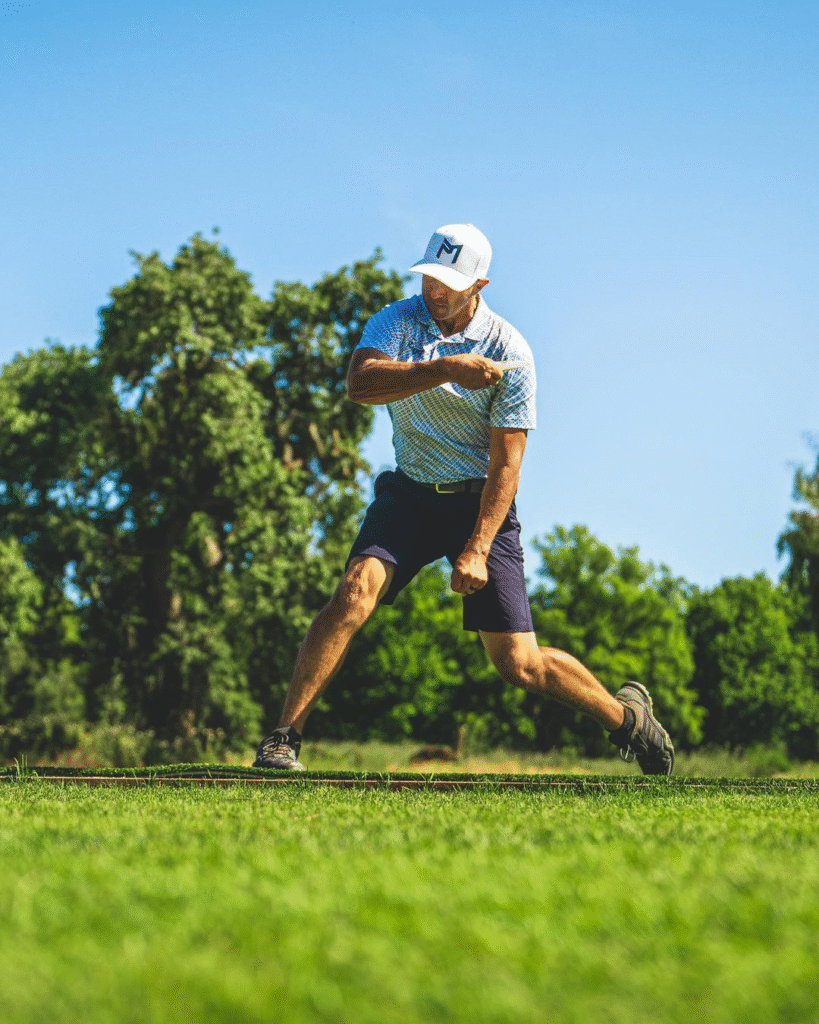Whether it be scratching your leg on a thorny vine or smashing your finger on a nearby tree, many disc golf injuries are avoidable. The way to reduce injuries is to understand what injuries disc golfers are most likely to encounter. There are injury studies that have focused on the sport of Ultimate Frisbee. But we can all agree, the injuries from running, jumping, and diving do not evenly compare to us comfortably throwing discs from a tee pad. So, the base for this article is from a 2015 study by Dr. Rahbek and the country of Denmark, as well as a 2015 study by Dr. Nelson. They conducted a survey of disc golfing citizens and their disc golf injuries.

A study on disc golf injuries from 2015
What are the most common injuries in disc golf?
According to the study, 13% were currently dealing with a disc golf injury. The most common injuries surveyed were affecting the player’s throwing shoulder (31%), followed by the player’s throwing elbow (20%). In fact, 92% of all injuries reported were affecting the player’s throwing side. And the 8% of injuries that occurred on player’s non-throwing sides were affecting their lower extremities (knees, ankles, etc.).
The study showed that the median duration of injuries was 240 days with 93% having a gradual onset. This means 93% of injuries were not sudden, rather they became worse as the players continued disc golfing with their injuries.
Warming up reduces injuries substantially!
The study also found that disc golfers regularly practice warmup routines for 5 minutes. Many studies into sports injuries have shown that warming up reduces injuries substantially. A structured warmup routine may be the best preventative measure any disc golfer can take to combat injuries.
5 minutes of warmup time may be the recorded average, but realistically a solid warmup is between 15-30+ minutes. This would consist of a variety of stretches, putts, and distance throws.
Here’s an excellent pre-round warm-up routine by Seth Munsey from Disc Golf Strong:
Biggest cause of disc golf injuries: Bad technique
43% of the disc golfers studied had no “technique-oriented guidance” in their first year of playing. Without engaging proper throwing form, players are forced to compensate by generating more power from their shoulder and elbow. This statistic alone may be the biggest cause of disc golf injuries.
The better you get, the greater your risk of injury!
Player’s reporting a lower score, and therefore a higher skill, were at a higher risk of injury. Higher skilled players play more tournaments and those tournaments demand a higher level of performance. Even in players with greatly developed throwing form, as the number of repetitive forceful throws per week increase, so too does the risk of injury.
Carrying a heavier disc golf bag can result in higher risk of injuries

Many ball-golf studies have found that carrying a golf bag can result in a higher risk of injury, the same pattern is sure to coincide with disc golf. Every course has obstacles and inaccessible terrain. A fall may be more severe or frequent while carrying a heavier bag.
If you are carrying more than 20 discs in your disc golf bag, take time to consider what you really need to complete a round of disc golf.
The most glaring facts of this study
The most glaring facts of this study are how many beginners are not instructed on proper disc-throwing form (43%), and how many players continue to play disc golf while they are nursing an injury (93%).
If you’re new to disc golf, don’t be timid. Ask for guidance from the disc golfers around you. Experienced disc golfers love to share their knowledge of proper throwing form. All you have to do is ask for tips.
If you’re not the social type, there are a ton of online resources to help with proper throwing form. YouTube videos from professional disc golfers are a great guide. And Facebook’s Disc Golf Form Check group can help pinpoint particularly troublesome actions in your throwing routine.
The most important thing to remember is give yourself time to let your body heal.

Disc golf injuries are almost inevitable
81% reported having an injury during disc golf at some point in their career. It’s almost inevitable that we will sustain some type of injury from disc golf. But, how we deal with that injury determines the outcome and sustainability of the injury.
Be smart! Injuries are not worth a round of disc golf
32% reported never receiving any treatment for their most serious injuries. If you choose to continue to play while having an injury, you could be setting yourself up for a more long-term injury. Be smart. A lifelong injury is not worth a round of disc golf. Staying safe will ensure that we are able to continue playing the game we love until the day we die.
Study conclusion:
Although disc golf is a low-impact sport suitable for all ages, playing can cause injuries. According to the Orthopedic Journal of Sports Medicine, more than 8 in 10 players report disc golf injuries. The most common conditions include sprains, strains, and tendinitis in the lower back, elbow, shoulder, and knee.
To avoid injuries while playing disc golf, focus on warming up first! A simple yet intense 5-minute warm-up can make a huge difference in reducing the risk of injury. In addition, it is important to build both strength and flexibility in the key muscle groups used during throwing, especially the shoulders, back, hips, and hamstrings. Build endurance with low-impact aerobic exercises such as stationary biking and walking.
Helpful resources:
Disc Golf Form Check Facebook group – A 33,000+ members strong disc golf form community on Facebook! One of the biggest of its kind. Join the community here – https://www.facebook.com/groups/1998173570395873
Disc Golf Fanatics Facebook group – This Facebook group is for all disc golfers to post questions, videos and anything else disc golf related! Join here – https://www.facebook.com/groups/discgolffanatic
Disc Golf Strong – Helping disc golf athletes of all skill levels, ages, and abilities play strong, healthy, injury-resistant, and resilient disc golf. Led by Seth Munsey, who is the Director of Health and Sports Performance at Disc Golf Pro Tour (DGPT). Check out their website here – https://www.discgolfstrong.com
Joonas Merelä – Science Based Coaching for Disc Golfers. Joonas Merelä is one of the first professional Performance Coaches in disc golf. Working with the Finnish National Disc Golf team and also works with multiple Disc Golf Pro-level players. Merelä: “I base everything I do with proven science.” Check out his website here – https://joonasmerela.com/
Overthrow Disc Golf – A coaching practice centered on helping players develop efficient, repeatable backhand form. Check out their YouTube channel here – https://www.youtube.com/c/OverthrowDiscGolf
Pulsea Disc Golf Academy – Pulsea Academy is the world’s biggest online academy with 1200+ lessons. Unlock your full potential and start learning from the best players in the game wherever you are. Start with the absolute basics or head to the pro-level videos — Let’s Go! Check out their website here – https://www.pulsea.com/
Article & study sources:
Original post/text source – https://www.facebook.com/permalink.php?story_fbid=129664052927261&id=107253795168287
INJURIES IN DISC GOLF – A DESCRIPTIVE CROSS-SECTIONAL STUDY – https://pmc.ncbi.nlm.nih.gov/articles/PMC4739042/
Disc Golf, a Growing Sport: Description and Epidemiology of Injuries – https://journals.sagepub.com/doi/full/10.1177/2325967115589076
As Disc Golf Fans Increase, So Do Injuries – https://www.palmharborortho.com/blog/as-disc-golf-fans-increase-so-do-injuries
Discover more from Disc Golf Fanatic
Subscribe to get the latest posts sent to your email.
